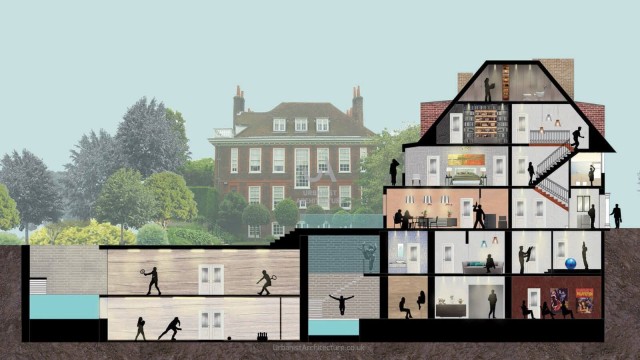Read next
The latest news, updates and expert views for ambitious, high-achieving and purpose-driven homeowners and property entrepreneurs.


It’s 2025, a time of groundbreaking innovation, rapid technological advancement, and shifting societal norms. Industries across the board are evolving at an unprecedented pace, breaking down outdated biases and embracing inclusivity.
Yet, architecture and construction remain anchored in an outdated paradigm where leadership is disproportionately male, and gender-based stereotypes continue to influence career trajectories.
While progress has been made, the gender gap in these professions is still significant. Women continue to face barriers to entry, slower career progression, and pay disparities that undermine their contributions.
The consequences of these barriers extend beyond individual careers. The underrepresentation of women in architecture and construction has a tangible impact on the built environment itself.
Research suggests that diverse design teams create more inclusive spaces, reflecting the needs of a broader population.
From urban planning that considers the safety of women in public spaces to housing that accommodates multigenerational living, the lack of gender diversity in decision-making results in environments that fail to address the full spectrum of societal needs.
This isn’t just an issue of representation, it’s a structural problem that affects the quality, innovation, and future of the built environment.
The stereotypical image of an architect - male, dressed in black, perpetually clutching a sketchbook and coffee - may seem trivial, but it reflects deeper biases.
The perception that architecture is a male-dominated field influences hiring practices, career expectations, and the visibility of women in leadership roles.
Danish architect Dorte Mandrup eloquently addressed this issue in her piece 'I am not a female architect. I am an architect'.
"Rarely are women known as female accountants, female lawyers, female taxi drivers or female journalists. But 'female architects' seems to be an unshakeable phrase."
"When we talk about gender, we tend to talk about women. Men do not really have a gender. They are... neutral. Non-gender. That is why you do not recognise the term 'male architect'. It just goes without saying."
The persistent classification of “female architects” reinforces the idea that architecture is inherently male, positioning women as an exception rather than an equal part of the profession.
If their work is worthy of recognition, why should it be confined to separate “female architect” sections in industry publications rather than included in the main discourse?
The gender gap in architecture and construction is not just anecdotal - it is clearly reflected in the data. In the UK:
In construction, the numbers are even more deflating:
A study conducted by The Architectural Review found that 88% of female architects felt their careers had been restricted or undermined due to having children.
Many felt forced to accept part-time roles, step back from leadership positions, or leave the profession entirely due to rigid work structures and an unsupportive culture.
This phenomenon, often referred to as the “leaky pipeline,” doesn’t just affect individual careers - it weakens the industry by diminishing the talent pool at senior levels, leading to less diverse leadership and decision-making.
These statistics are not just numbers - they represent real barriers preventing women from progressing in fields where their talent and expertise are desperately needed.
The misconception that architecture and construction are inherently masculine starts early.
From childhood, boys are encouraged to play with building sets, while girls are steered toward dolls and domestic play. These subtle reinforcements shape career aspirations long before professional choices are consciously made.
The story of Teresa Borsuk is a stark example. She knew from the age of eight that she wanted to be an architect but faced constant pressure to consider interior design instead - viewed as a more “appropriate” field for women.
Even after qualifying, she encountered systemic bias, which ultimately contributed to her leaving her early London practice.
These barriers persist due to ingrained beliefs that women are less suited for certain professions, or that their roles as caregivers make them unreliable professionals.
One of the most insidious aspects of this bias is the assumption that female architects and construction professionals are less ambitious or committed to their careers.
This perception, despite being widely disproven, continues to influence hiring and promotion decisions.
A 2023 report by the Architects Registration Board (ARB) highlighted that while nearly half of newly registered architects in the UK are women, this figure drops significantly at senior levels, suggesting that institutional obstacles rather than personal choices are driving the gender gap.
These assumptions have been disproven repeatedly by research, yet they continue to shape hiring and promotion practices.
One particularly revealing incident occurred during our recruitment process at Urbanist Architecture. I received an application from a RIBA chartered architect with over two decades of experience who, on paper, appeared to be an exceptional candidate.
However, in describing his previous workplace experience, he specifically noted having worked in a team "led by a younger female architect" alongside "a younger female technician."
The deliberate emphasis on both "young" and "female" was jarring - neither characteristic being relevant to professional capability. It revealed an underlying discomfort with female leadership and a worldview where women in positions of authority required special notation.
The implication was clear: he considered it unusual or perhaps even inappropriate for women to hold architectural leadership positions, particularly over men with extensive experience.
This kind of bias isn’t just anecdotal - it’s systemic. A survey by the Association of Collegiate Schools of Architecture found that women in architecture frequently experience “second-generation bias,” a subtle yet pervasive form of discrimination where workplace norms and expectations favour men, often without explicit intention.
This results in fewer opportunities for mentorship, slower career progression, and a persistent underrepresentation of women in leadership roles.
This subtle but unmistakable expression of bias made the decision straightforward, I rejected his application.
At Urbanist Architecture, we understand that genuine inclusivity starts with recognising and challenging these ingrained perspectives, even when they manifest in seemingly minor linguistic choices.
Women in architecture and construction don’t just face entry barriers - they are systematically pushed out mid-career.
Take Yanel de Angel, who, after nearly two years at an English architectural firm and a decade in the profession, announced her pregnancy.
Rather than support, she was immediately removed from all projects “for the sake of continuity.” Within months, her design responsibilities were replaced with administrative tasks.
“It made me feel penalised, as if my contributions were dismissed due to the physical changes in my body,” she recalled. “It made me question if I could have a career and a family.”
She is not alone.
47% of women architects believe having children puts them at a professional disadvantage, compared to just 7% of men.
This “motherhood penalty” is one of the key reasons women leave the profession, contributing to the leaky pipeline that drains architecture and construction of experienced female professionals.
Beyond fairness, gender diversity in architecture and construction directly impacts innovation and profitability.
Beyond financial performance, gender diversity also enhances project outcomes. Research by the Centre for Creative Leadership found that teams with balanced gender representation are more effective at risk management and problem-solving - key factors in industries like construction, where safety and efficiency are paramount.
The presence of women on construction sites has also been linked to a decrease in workplace conflicts and a shift toward more collaborative work environments.
At Urbanist Architecture, we have seen this firsthand. With more than 70% of our consultants being women, more than double the industry average, we are not just breaking gender norms; we are building a widely acclaimed architectural practice that benefits from diverse voices, leading to better design, more inclusive spaces, and a stronger business.
Closing the gender gap requires comprehensive industry-wide transformation.
Here’s how we can move forward:
Achieving gender equity in architecture and construction isn’t just the responsibility of women - it requires industry-wide commitment. Men in positions of power must actively champion change, recognising that diversity isn’t a concession but a catalyst for excellence.
For too long, architecture has built magnificent structures while failing to build an inclusive profession.
It’s time to redesign the culture of our industry alongside our cities, ensuring that the built environment reflects the full spectrum of human experience, because the future of architecture must belong to everyone.
As Zaha Hadid, the first woman to win the Pritzker Architecture Prize, once said: “I really believe in the idea of the future.”
Let’s make sure architecture’s future is one where talent, not gender, determines opportunity.
We want to hear your perspectives. Share your experiences or ideas on how we can close the gender gap in architecture and construction.
Have you witnessed positive change in your workplace? What more needs to be done?
Let’s work together to create a profession that values talent over tradition and equity over exclusion. The time for change is now.

Urbanist Architecture’s founder and managing director, Ufuk Bahar BA(Hons), MA, takes personal charge of our larger projects, focusing particularly on Green Belt developments, new-build flats and housing, and high-end full refurbishments.
We look forward to learning how we can help you. Simply fill in the form below and someone on our team will respond to you at the earliest opportunity.
The latest news, updates and expert views for ambitious, high-achieving and purpose-driven homeowners and property entrepreneurs.
The latest news, updates and expert views for ambitious, high-achieving and purpose-driven homeowners and property entrepreneurs.










We specialise in crafting creative design and planning strategies to unlock the hidden potential of developments, secure planning permission and deliver imaginative projects on tricky sites
Write us a message